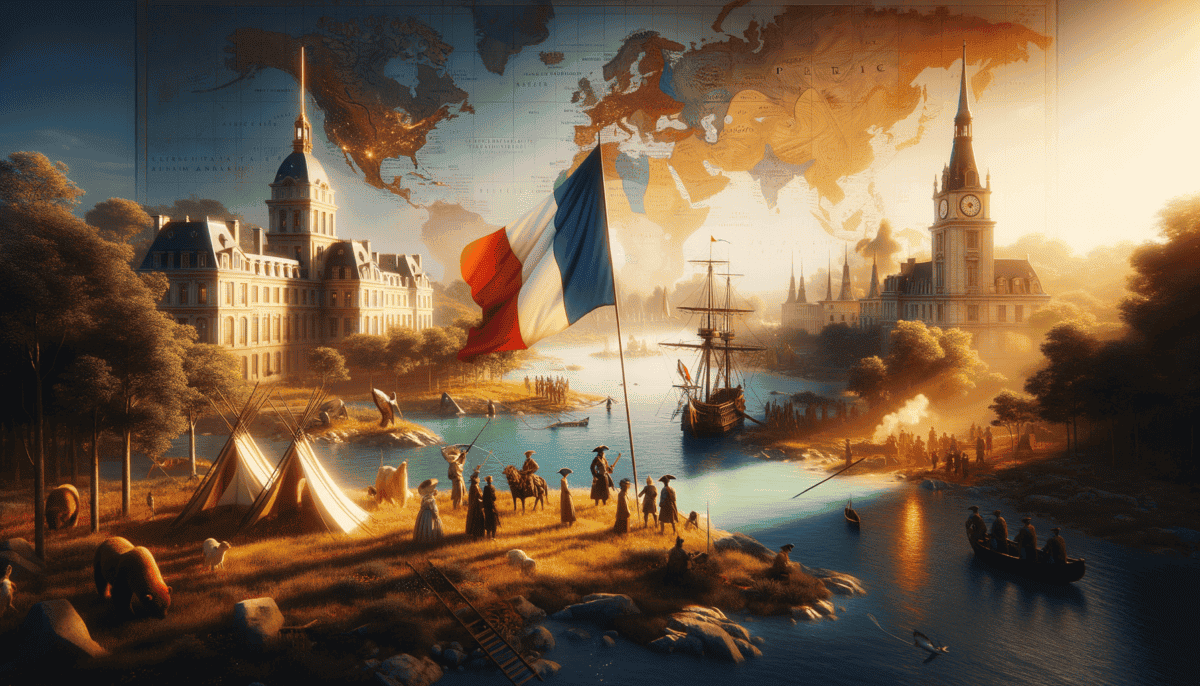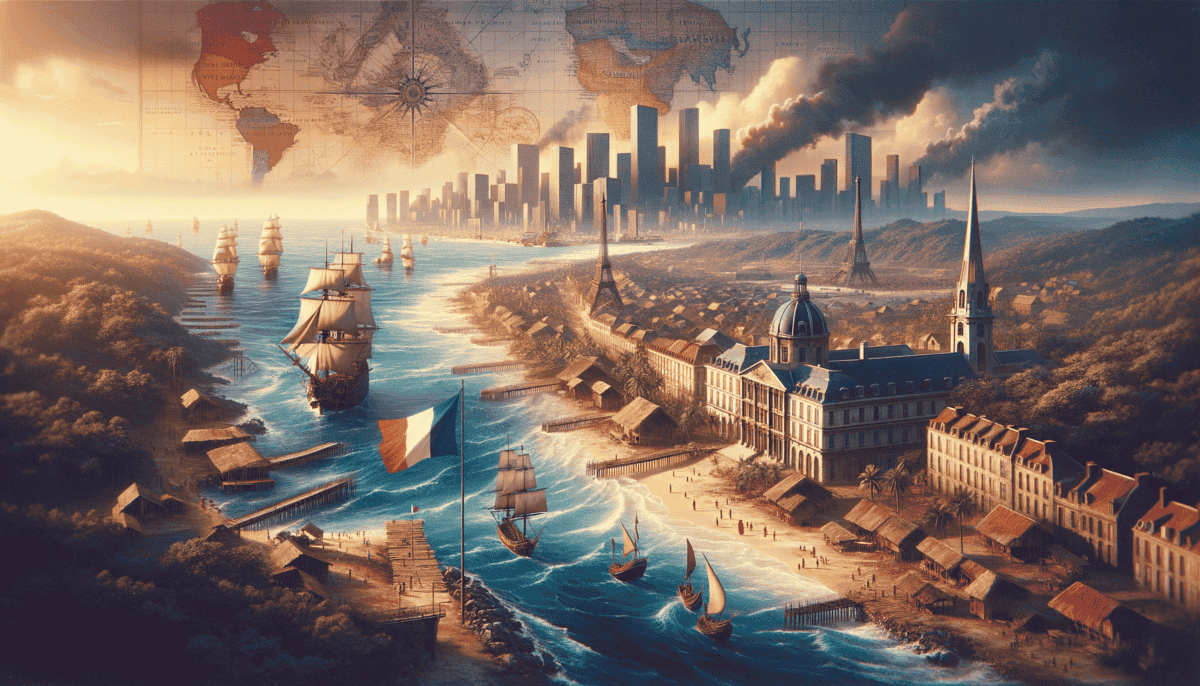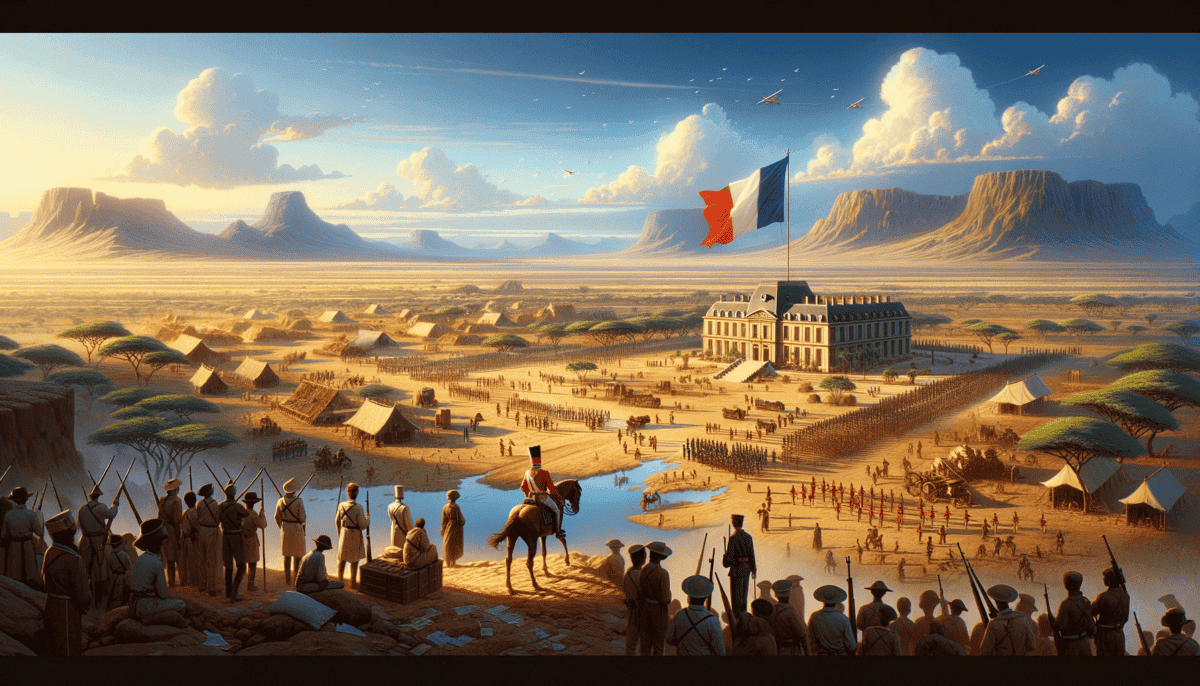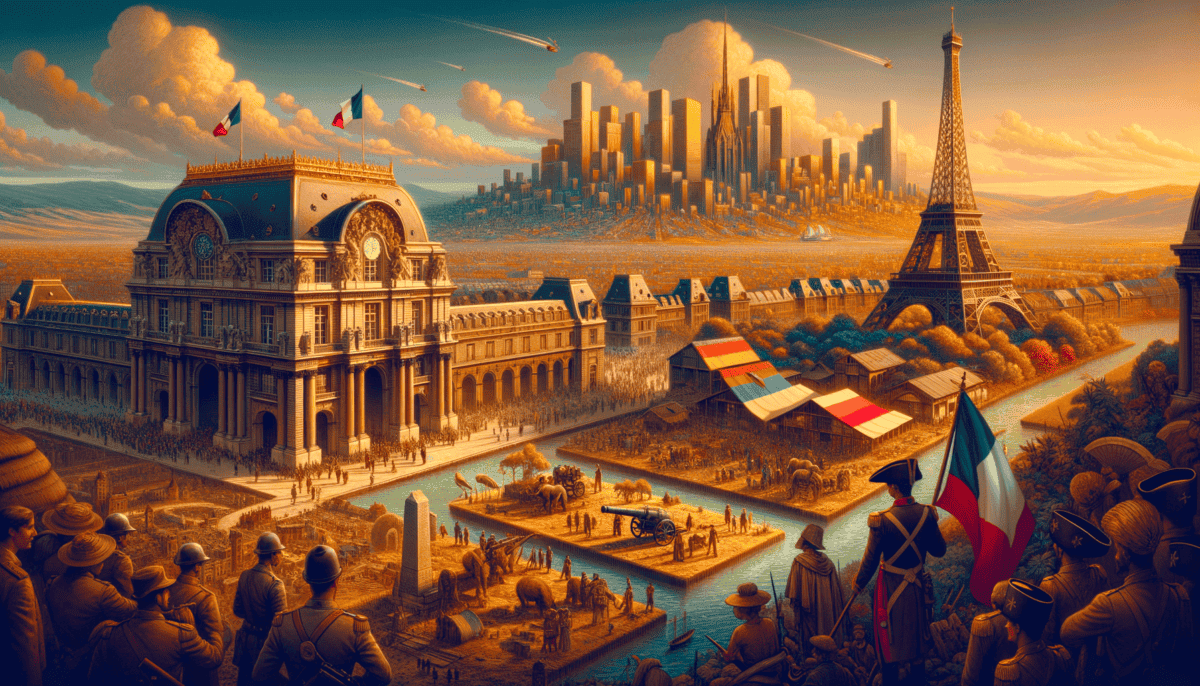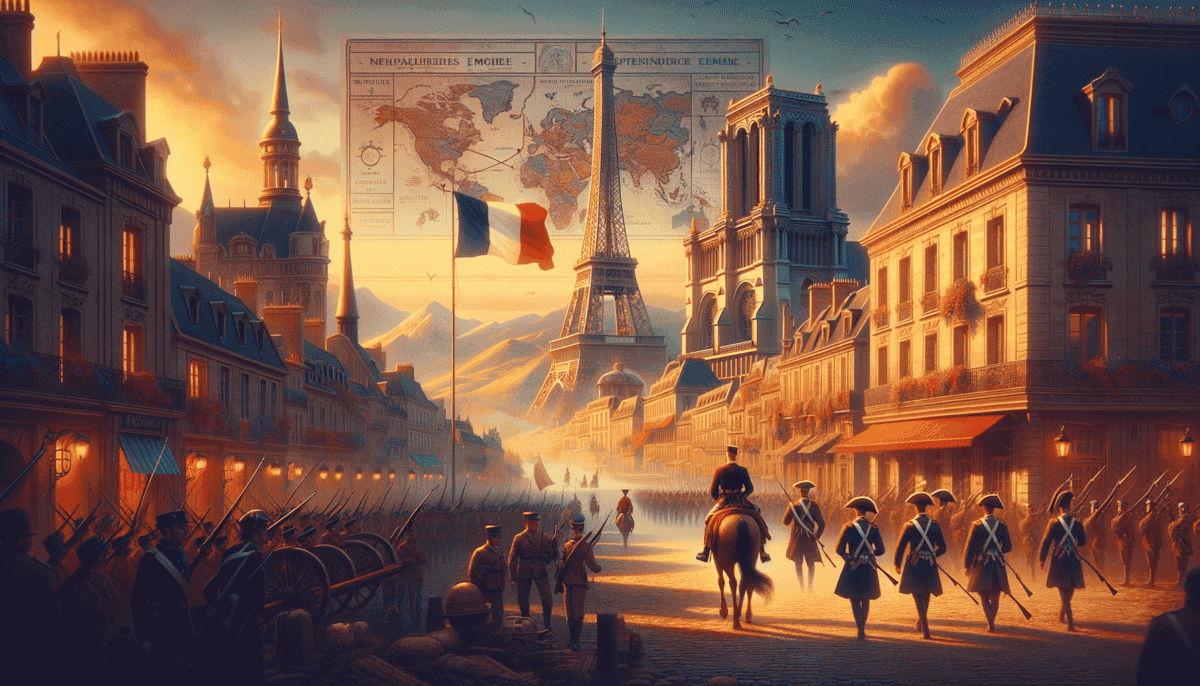Seeds of Ambition
The salty sea breeze whipped through Pierre's hair as he stood on the deck of his father's ship. The year was 1524, and the young boy could hardly contain his excitement. At just ten years old, he was about to witness history – his father, Jacques Cartier, was leading one of France's first big adventures across the ocean!
"Papa, will we find new lands?" Pierre asked, gripping the wooden railing.
His father smiled, adjusting the ship's wheel. "That's why King Francis sent us, mon fils. France needs to find new places, just like Spain did!"
The morning sun painted the waves golden as their ship, La Grande Hermine, cut through the Atlantic waters. Below deck, sailors checked their maps and supplies. They had packed enough food and water for many months at sea.
Pierre watched as another sailor climbed up to the crow's nest. "What are we looking for?" he called up.
"Land, new trade routes, and riches for France!" the sailor shouted back. "The king wants us to catch up with other countries that already have colonies!"
Life at sea wasn't easy. The waves could be very big, and storms made the ship rock back and forth. But the French sailors were brave. They knew they were doing something important for their country.
Making New Friends
After many weeks at sea, they finally saw land! It wasn't the Asia they were looking for, but something even more exciting – a whole new world! The ship anchored near what we now call Canada.
"Look, Papa!" Pierre pointed to the shore where some Native American people were approaching in canoes. They were Iroquois, and they were curious about these strange visitors.
The French sailors traded with the Iroquois people, giving them metal tools and getting warm fur coats in return. It was the start of something big – France's first step toward building what would become a huge empire!
“Remember this day, Pierre,” Jacques said to his son. “Today, we plant the flag of France in new soil. This is just the beginning of our great adventures!”
Throughout the rest of the century, more French ships would follow. They set up trading posts and made friends (and sometimes enemies) with different Native American tribes. Some brave French people even decided to live in these new lands!
Growing Dreams
Back in France, King Francis was very happy. His explorers had found new lands where France could grow stronger. They brought back stories of vast forests, rich fishing grounds, and friendly native peoples who could help them learn about these new places.
Pierre grew up to become an explorer like his father. He watched as France sent more ships, more people, and built more colonies. It wasn't always easy – the weather could be harsh, food sometimes ran out, and there were fights with other European countries who also wanted these new lands.
But the French were determined. They learned to build better ships that could sail faster and carry more supplies. They made maps of the new places they found and wrote down everything they learned about the people, animals, and plants they discovered.
Young sailors dreamed of following in the footsteps of explorers like Jacques Cartier. They wanted to find new lands and make France stronger. Each new discovery made France's dreams of having a big empire seem more possible.
The seeds of French ambition were planted in these early days of exploration. These brave sailors and their adventures would lead to France building one of the biggest empires in history. From these small beginnings on wooden ships, France would go on to rule lands all around the world.
The New World Beckons
The morning fog lifted slowly over the St. Lawrence River. Samuel de Champlain stood proudly on a rocky cliff in 1608. Below him, workers were building the first houses of Quebec City. This would be France’s new home in North America!
“Monsieur Champlain,” called out young Jean, his helper. “The Native Americans are here to trade furs again!”
Down by the river, canoes full of soft beaver pelts arrived. The Huron people paddled expertly through the water. They had become good friends and trading partners with the French.
“Welcome, my friends!” Champlain called out in their language, which he had worked hard to learn. The Native Americans smiled and waved back.
Building a New Home
Life in New France wasn’t easy. The winters were very cold, much colder than in France. But the French settlers, called habitants, learned clever ways to survive:
- They built strong wooden houses
- They learned to hunt like the Native Americans
- They planted gardens in the short summer
- They made warm clothes from animal furs
“Look how our town grows!” Jean said excitedly. More ships arrived from France, bringing new families ready to start a new life.
“This land will be our new home,” Champlain told the settlers. “We must work together with our Native American friends to make it strong.”
The Fur Trade Adventure
The most exciting part of life in New France was the fur trade! Young French men called coureurs des bois (forest runners) traveled deep into the wilderness to trade with Native Americans.
“Tell us about your adventures!” children would beg when the traders returned.
The traders would share stories about paddling huge canoes through rushing rivers, meeting different Native American tribes, and seeing amazing animals like moose and bears.
Growing Together
As more French people arrived, they built new towns along the St. Lawrence River. They called this growing colony New France. French families worked hard to clear land for farms.
Many French people became good friends with the Native Americans. They learned from each other:
The Native Americans taught the French about:
• How to survive in the cold winters
• Which plants were good to eat
• How to travel by canoe
The French shared:
• New tools made of metal
• Different ways to cook food
• How to write things down
Challenges in the New World
Not everything was easy in New France. Sometimes there were fights with English colonies nearby. The weather could be very harsh, and food was sometimes hard to find.
“But we are strong together,” Champlain would say. “French and Native American friends working as one.”
Over time, more towns appeared along the rivers and lakes. French missionaries built churches and schools. Farmers grew crops in the rich soil. The colony was growing!
Young Jean grew up watching Quebec City become bigger and stronger. “Monsieur Champlain,” he said one day, “I think we did it. We really built something special here.”
Champlain smiled, looking out over the bustling town that had grown from nothing. The French flag flew proudly over the fortress, and below, French and Native American children played together in the streets.
Sweet Sugar and Salty Seas
The warm Caribbean sun sparkled on the blue waves. Marie-Claire stood on the dock of Saint-Domingue, watching ships loaded with sugar cane sail toward France. The year was 1750, and this tiny island had become one of France’s most valuable colonies.
“Papa, another ship is coming!” Marie-Claire called to her father, who managed one of the biggest sugar plantations.
Life on Sugar Island
The air was always sweet with the smell of sugar cane. Huge fields of tall green plants stretched as far as anyone could see. But life on the sugar plantations was not sweet at all.
“Look at how much sugar we make!” said Pierre, Marie-Claire’s little brother, pointing to the bags being loaded onto ships.
“Yes, but remember what Mama says – we must never forget the terrible price of this sugar,” Marie-Claire whispered.
A Painful Truth
The sugar plantations used enslaved people who were taken from Africa. They worked very hard in the hot sun. It was wrong and cruel. Many brave enslaved people fought for their freedom.
Island Life Changes Everything
The French Caribbean islands were very different from France. New foods, music, and ways of talking mixed together. This created new and special island cultures!
Things that made the Caribbean special:
- Spicy foods with peppers and tropical fruits
- New music that mixed African and French sounds
- Colorful clothes made for hot weather
- Special ways of speaking called Creole
Fighting Over Paradise
“Ships on the horizon!” shouted the lookout one morning. “English warships!”
The French weren’t the only ones who wanted these islands. England and Spain also fought to control them. Sometimes there were big battles at sea! ⚔️
Changes Coming
One evening, Marie-Claire heard the enslaved people singing. Their songs were full of hope for freedom. She knew things would have to change.
“The old ways cannot last forever,” her mother said softly. “Everyone deserves to be free.”
The sound of drums echoed from the hills at night. In slave quarters across the island, people dreamed of liberty. They told stories of brave leaders who would help them break free.
A New Way of Life
Marie-Claire watched as island life created new things:
• New kinds of food with tropical fruits
• Special island music and dances
• Different ways to build houses for hot weather
The French who lived on the islands learned many things from the African and Caribbean people:
• How to cook with local spices
• Ways to survive tropical storms
• New songs and stories
As the sun set over the Caribbean Sea, Marie-Claire thought about all the changes happening around her. She could feel that big changes were coming to these sugar islands. The wind carried the sound of freedom songs across the water, promising a different tomorrow.
Dreams and Dust in Africa
The hot African sun beat down on young Jean-Pierre as he watched French ships arrive at the port of Dakar in 1880. All around him, people were busy building new roads and buildings. France wanted to make Africa part of its big empire.
A New Adventure
“Look at all the changes, Papa!” Jean-Pierre called out to his father, who worked as a builder.
“Yes, my son. But remember – this land belonged to African people long before we came here,” his father replied wisely.
Meeting New Friends
Jean-Pierre made friends with Moussa, a local boy his age. They shared lunches and taught each other games.
“Your French words are funny,” Moussa laughed.
“And your Wolof words are hard to say!” Jean-Pierre giggled back.
Brave African Leaders
Not everyone wanted France to take over their land. Many brave African leaders fought back:
- Samory Touré led his people against French armies
- Queen Sarraounia protected her kingdom
- El Hadj Umar Tall built a strong empire
- Béhanzin fought to keep his kingdom free
Changes in the Land
The French made big changes in Africa:
• Built new cities and roads
• Started schools that taught French
• Changed how people farmed the land
Desert Adventures
Jean-Pierre traveled with his father across the Sahara Desert. They saw amazing things:
“The desert is like an ocean of sand,” he wrote in his diary. “The stars at night shine brighter than I’ve ever seen!”
Working Together
Some French and African people worked together to make things better:
• Doctors helped sick people
• Teachers shared knowledge
• Farmers learned from each other
Growing Unhappiness
As Jean-Pierre grew older, he saw that many African people were unhappy. They wanted to rule their own lands again.
“One day,” Moussa told him, “Africa will be free again. But we can still be friends.”
Taking Resources
The French took many valuable things from Africa:
New Ideas Grow
Jean-Pierre noticed more and more African people wanting change. They started newspapers and groups to talk about freedom.
His friend Moussa joined a school where students learned about their rights. “We want to make our own choices,” Moussa explained.
As the sun set over Dakar, Jean-Pierre thought about all he had learned. He knew Africa was changing. The wind carried the sounds of both French and African songs across the city, telling stories of two worlds meeting.
Dragons of the East
The warm breeze carried the scent of spices through the bustling streets of Hanoi in 1885. Marie, a young French girl, watched dragon boats glide across the lake while her mother taught at a new school.
New Friends in a Far Land
“Bonjour!” Marie waved to Mai, a Vietnamese girl her age selling flowers nearby.
“Chào bạn!” Mai replied with a bright smile, teaching Marie how to say hello in Vietnamese.
The two girls became fast friends, sharing stories and snacks after school.
A Land of Wonders
Marie wrote in her diary about all the amazing things she saw:
- Beautiful temples with golden roofs
- Rice fields that looked like green stairs
- Markets full of silk and spices
- Water puppets dancing on lakes
Changes Big and Small
The French made many changes in Vietnam:
• Built new roads and bridges
• Started French-Vietnamese schools
• Planted rubber trees and coffee
Brave Hearts
Marie learned about Vietnamese heroes who fought for their homeland:
• Emperor Ham Nghi led armies against the French
• Scholar Phan Boi Chau wrote about freedom
• The Trung Sisters became symbols of hope
Two Worlds Meet
Sometimes French and Vietnamese ways mixed together in fun ways:
“Look, Marie!” Mai showed her a painting. “The artist used French paint to draw Vietnamese dragons!”
Learning Together
In school, Marie and Mai helped each other:
Growing Understanding
As Marie grew older, she noticed more things about life in Vietnam:
“Why do some people look sad when they work in the rubber fields?” she asked her mother.
Dreams of Change
Mai shared her hopes with Marie: “One day, Vietnam will rule itself again. But we’ll always be friends.”
Rich Culture
Marie learned to love Vietnamese traditions:
• The beautiful Tet New Year festival
• Stories about wise dragons
• Sweet rice cakes and noodle soups
Signs of Tomorrow
More and more Vietnamese people started talking about freedom. They opened newspapers and schools to share their ideas.
“Changes are coming,” Mai’s father told them. “Like the changing seasons.”
As lanterns lit up the evening sky over Hanoi’s lake, Marie watched dragon boats float by. The sound of Vietnamese songs mixed with French music, telling stories of two different worlds learning to understand each other.
Winds of Change
The year was 1954, and Paris buzzed with news from far away. Little Pierre sat by the radio with his grandfather, who had once lived in Vietnam.
Stories from Yesterday
“Tell me about the old days, Grandpa,” Pierre asked, clutching his favorite toy boat.
“We thought we could rule the world forever, petit. But times change, like the tides.”
Freedom Calls
All across the world, people wanted to be free:
- Vietnam fought for independence
- African countries raised new flags
- Islands in the Caribbean chose their own leaders
- Madagascar became its own nation
New Beginnings
Pierre’s teacher showed the class a big map. Where there used to be French colors, new country names appeared: ️
Lasting Connections
Even as countries became independent, they kept some French things:
• French words mixed into their languages
• French food like bread and pastries
• Schools that taught both ways
Making Friends
Pierre made new friends at school:
“My family is from Algeria,” said Ahmed, sharing his lunch. “And mine is from Senegal,” smiled Fatou.
Sweet Memories
Grandpa showed Pierre old photos from his time overseas:
Learning from the Past
Pierre’s class learned important lessons: ✏️
“We must respect all people and their right to be free,” their teacher said. “That’s how we build a better world.”
Sharing Cultures
The school had a special celebration day. Everyone brought something to share:
Vietnamese spring rolls, African drums, Caribbean songs, and French croissants all came together.
A Better Tomorrow
Pierre wrote in his notebook about what he learned:
New Adventures
As Pierre grew older, he dreamed of visiting these places, not to rule them, but to learn from them.
His grandfather smiled, “That’s the right way, petit. Go as a friend, not a ruler.”
The World Today
Now, people from all the old French colonies visit France, and French people visit them too. They share:
• Music and art
• Food and stories
• Ideas and dreams
Looking Forward
Pierre looked at his globe, spinning it gently. Each country had its own flag now, its own voice. But they weren’t strangers anymore – they were neighbors in our big world family.
As the sun set over Paris, Pierre thought about all the new friends waiting to be made across the seas. The old empire was gone, but something better had grown in its place: friendship between free peoples.


